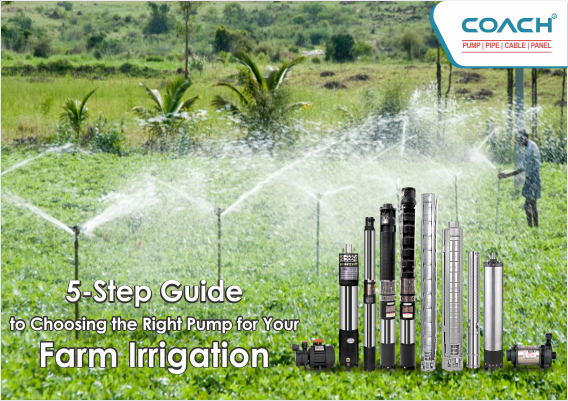A 5-Step Guide to Choosing the Right Pump for Your Farm Irrigation
- December 1, 2022
- Category :Submersible Pump & Motor

Introduction:
Farm irrigation is a critical component of agricultural success, and selecting the right pump is essential for efficient water distribution. With numerous pump options available, it can be overwhelming to determine which one suits your specific farm irrigation needs. In this blog post, we will provide you with a comprehensive 5-step guide to help you make an informed decision and choose the perfect pump for your farm irrigation system.
Step 1: Assess Your Water Requirements:
The first step in selecting the right pump is to assess your farm’s water requirements. Consider factors such as the size of your field, crop type, soil type, and climate conditions. Calculate the total water volume needed and determine the required flow rate and total dynamic head (TDH), which refers to the vertical and horizontal distance the pump needs to move water. Understanding your water requirements will provide a solid foundation for choosing an appropriate pump.
Step 2: Understand Pump Types:
Familiarize yourself with the different types of pumps available for farm irrigation. The most common options include centrifugal pumps, submersible pumps, and turbine pumps. Centrifugal pumps are versatile and suitable for various applications. Submersible pumps are ideal for deep wells or water sources, while turbine pumps work well in high-head applications. Each type has its own advantages, so choose one that aligns with your specific needs.
Step 3: Evaluate Pump Capacity and Efficiency:
After understanding your water requirements and pump types, evaluate the capacity and efficiency of the pumps you’re considering. Look for pumps that can meet or exceed your required flow rate and TDH. Pay attention to the pump’s performance curves, which show the relationship between flow rate, TDH, and efficiency. Opt for a pump that operates efficiently to minimize energy consumption and reduce operating costs in the long run.
Step 4: Consider Power Source and Installation:
Determine the power source available on your farm. Pumps can be powered by electricity, diesel, gasoline, or even solar energy. Consider factors such as availability, cost, and reliability when choosing a pump based on the power source. Additionally, assess the installation requirements of the pump. Some pumps are designed for above-ground installations, while others are submersible and require a well or water source. Select a pump that suits your power source and installation needs.
Step 5: Consult with Experts and Compare Options:
Seek advice from agricultural experts or pump suppliers to gain valuable insights tailored to your farm’s irrigation needs. They can provide expert recommendations and guide you towards the best pump options. Compare different pump models based on factors such as reliability, warranty, maintenance requirements, and cost. Take into account the long-term operational costs, including maintenance and repairs, when making your final decision.
Final Thoughts:
Choosing the right pump for your farm irrigation system is crucial for maximizing efficiency and ensuring the success of your agricultural endeavors. By following this 5-step guide, you can make an informed decision and select a pump that meets your water requirements, operates efficiently, and suits your power source and installation needs. Take your time to research and consult with experts to make the best choice, and enjoy the benefits of a well-designed and effective farm irrigation system.
Visit COACH pumps today to select the right pump for your farm irrigation.






